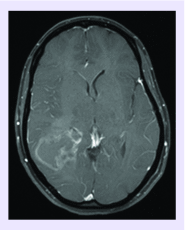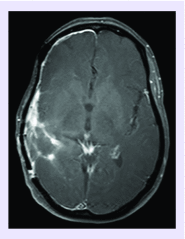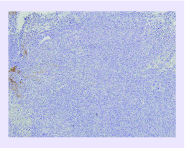Case of glioblastoma patient treated with tumor treating fields therapy at recurrence degenerating to sarcoma
- PMID: 28303729
- PMCID: PMC6020874
- DOI: 10.2217/cns-2016-0035
Case of glioblastoma patient treated with tumor treating fields therapy at recurrence degenerating to sarcoma
Abstract
Optune® treatment is a US FDA-approved treatment for glioblastoma (GBM) that employs alternating electric fields. Tumor treating field (TTF) therapy can exert its effects on GBM via cell cycle mitosis disruption and cytokinesis. We describe a patient with recurrent GBM who had disease progression following standard surgical treatment and concomitant chemoradiotherapy, and was found to have sarcomatous transformation after initiation of TTF therapy with bevacizumab. Upon tumor progression, repeat surgical resection revealed transformation into a GFAP-negative, reticulin-positive sarcoma with rhabdomyoid features. The possibility of a causal connection between TTF therapy and sarcomatous transformation needs to be further evaluated. No such case of apparent sarcoma formation in the CNS following chemoradiotherapy and/or TTF treatment for GBM has been reported.
Keywords: Optune®; glioblastoma; glioma; recurrence; sarcoma; tumor treating fields.
Conflict of interest statement
Figures





Similar articles
-
First report of tumor treating fields use in combination with bevacizumab in a pediatric patient: a case report.CNS Oncol. 2017 Jan;6(1):11-18. doi: 10.2217/cns-2016-0018. Epub 2016 Dec 5. CNS Oncol. 2017. PMID: 27918194 Free PMC article.
-
Alternating electric tumor treating fields for treatment of glioblastoma: rationale, preclinical, and clinical studies.J Neurosurg. 2018 Feb;128(2):414-421. doi: 10.3171/2016.9.JNS16452. Epub 2017 Feb 24. J Neurosurg. 2018. PMID: 28298023 Free PMC article.
-
Tumor treating field therapy in combination with bevacizumab for the treatment of recurrent glioblastoma.J Vis Exp. 2014 Oct 27;(92):e51638. doi: 10.3791/51638. J Vis Exp. 2014. PMID: 25407354 Free PMC article.
-
Rationale and Background on Tumor-Treating Fields for Glioblastoma.Clin J Oncol Nurs. 2016 Oct 1;20(5 Suppl):S20-4. doi: 10.1188/16.CJON.S1.20-24. Clin J Oncol Nurs. 2016. PMID: 27668387
-
Efficacy and Safety of Treating Glioblastoma With Tumor-Treating Fields Therapy.Clin J Oncol Nurs. 2016 Oct 1;20(5 Suppl):S9-S13. doi: 10.1188/16.CJON.S1.9-13. Clin J Oncol Nurs. 2016. PMID: 27668388 Review.
References
-
- Vymazal J, Wong ET. Response patterns of recurrent glioblastomas treated with tumor-treating fields. Semin. Oncol. 2014;41(Suppl. 6):S14–S24. - PubMed
-
•• Contributes to the mechanism of action of tumor-treating fields, explaining how these alternating electrical fields inhibit mitosis, specifically during cytokinesis.
-
- Hondroulis E, Melnick SJ, Zhang X, Wu Z-Z, Li C-Z. Electrical field manipulation of cancer cell behavior monitored by whole cell biosensing device. Biomed. Microdevices. 2013;15(4):657–663. - PubMed
-
- Puzzilli F, Ruggeri A, Mastronardi L, Di Stefano D, Lunardi P. Long-term survival in cerebral glioblastoma. Case report and critical review of the literature. Tumori. 1998;84(1):69–74. - PubMed
-
- Stupp R, Mason WP, van den Bent MJ, et al. “Radiotherapy plus concomitant and adjuvant temozolomide for glioblastoma”. N. Engl. J. Med. 2005;352(10):987–996. - PubMed
-
• Explains the rationale behind why we administered concurrent radiotherapy with temozolomide to the patient.
Publication types
MeSH terms
LinkOut - more resources
Full Text Sources
Other Literature Sources
Medical
Miscellaneous
